Fritzie Sparks, my best friend’s mother, was fond of saying “Stress is the thing,” whenever the topic of illness came up in conversation. She’d tap the tips of her fingernails on the table or countertop to drive the point home. That was back in the ’70s, and it was just one of those things teenagers would find amusing about parents, but now that I’ve drifted into the older generation she once occupied, I can better appreciate her wisdom. In my teens the only things I recall being stressed about were acne and getting better grades than Mike Sharmin and Doug Shaffer, my high-school rivals. Now I have a long list of worries from an ongoing pandemic and pants growing ever tighter to meeting work deadlines and living in a 100-year-old house in an earthquake zone that’s bracing for the “big one.”
For the past month, as the gloom of winter’s coming has darkened the skies of shortened days, I’ve chosen to take refuge not from the rain but in it. I’ll put on a couple of pile jackets, a knit hat, and my cagoule and sit in the back yard on a boat cushion set on an upside-down 5-gallon bucket—an orange one from Home Depot. The raindrops falling on my hood sound like salt sprinkled into a paper bag.
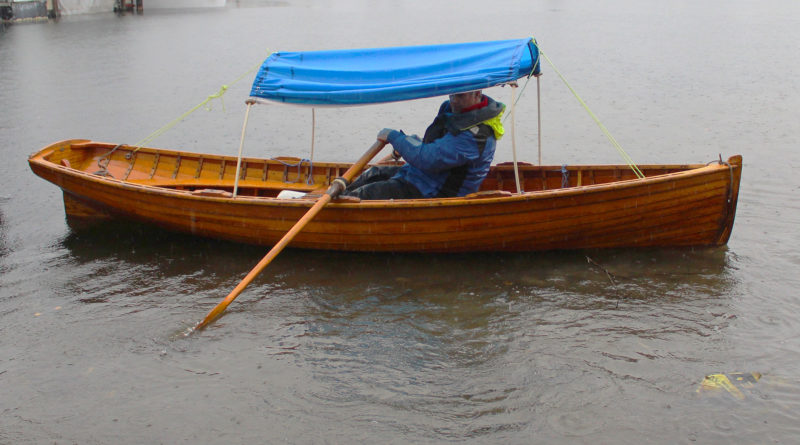
With the sides of the canopy pulled up, I can row with enough shelter to keep my head and hands dry. Even though I have good rain gear, I feel less soggy with a roof over my head.
I recently read that the sound of rain has a soothing effect that’s related to an elevated level of alpha waves generated by the brain. It’s a response that is also associated with meditation. I’d first heard of alpha waves when I was in college in the late ’70s and I was swept up in two trends that made short-lived marks on my generation: Earth shoes and Transcendental Meditation. I wore a pair of the first model of those shoes—with lowered heels and wide, squared toe boxes that looked like cartoon duck feet—when I took an off-campus class in TM. In my early practice of TM, I reached the bottom of the bubbles, as my instructor called reaching a state of thought-free wakefulness, just once. Having experienced that state of quietude and then being unable to reach it again, I meditated only sporadically in the years that followed.
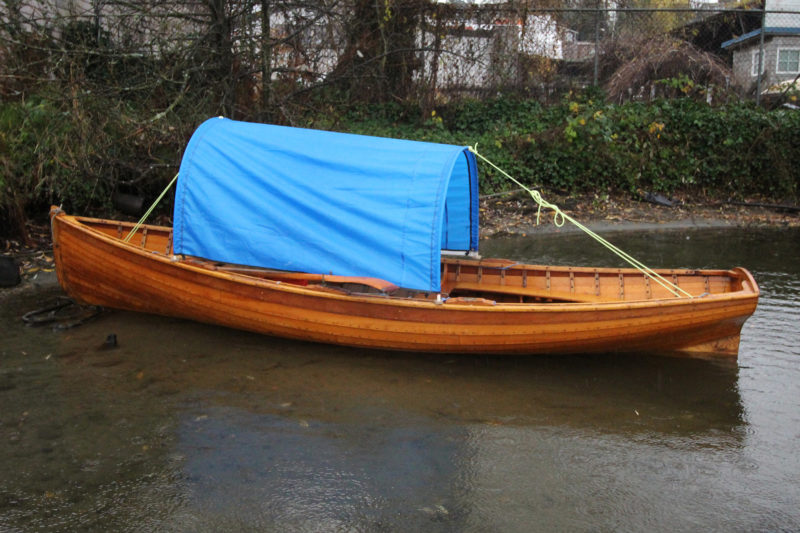
The Ship Canal where I often row has a few out-of-the-way places where I can sit in the Whitehall and enjoy the rain.
Now, when I hear rain outside of my study and see the bright scintillas of rain on the garage’s flat tar-black roof, I’ll sit in the rain and do a 20-minute session of TM. The double dose of alpha waves seems to work. In the rain, I get to the bottom of the bubbles with a reassuring frequency.
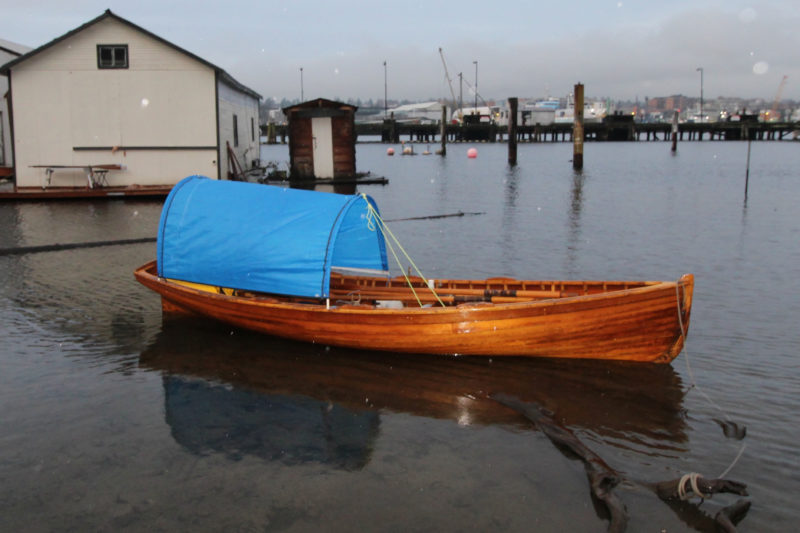
I move the canopy aft to make a cozy nest on the floorboards surrounded by the sternsheets.
On my first cruise up the Inside Passage, I frequently rowed for hours at a stretch and would often fall into a meditative state, listening to the metronomic rhythm of the oars. The memory of those pleasant days prompted me to switch my rainy-day practice from my orange bucket to the lapstrake Whitehall I’d built in 1983. I made a canopy for it not just as shelter from the rain but also as a resonator for it, to gather more sound than my cagoule can.
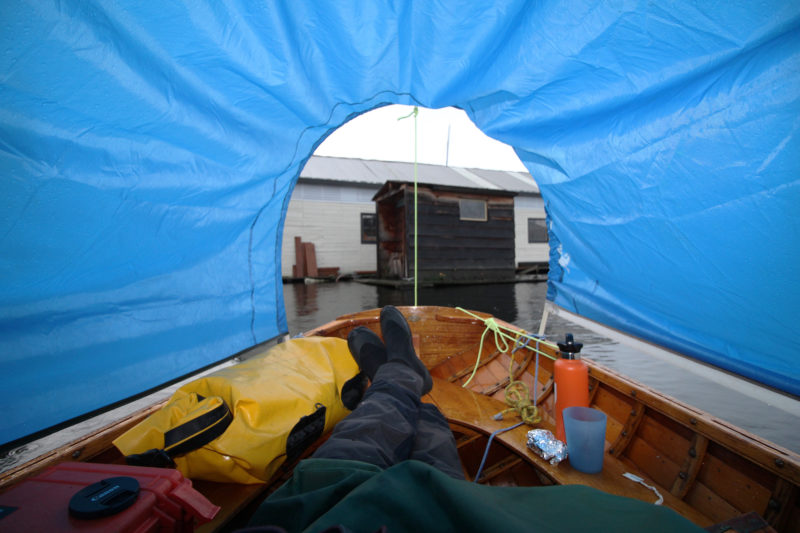
Snug in the stern, I had a cup of hot peppermint tea and a slab of banana bread with walnuts and dates, still warm from the oven.
When I go rowing on Seattle’s Ship Canal, the rain and mist mute sound and color. The wail of cars and trucks rolling across the metal grate of the bascule bridge adjacent to the launch ramp is no more than a murmur, and the trees and buildings on hills flanking the waterway appear as if dusted with soot and ash. On the smooth surface of the water, raindrops make their chain-mail pattern of interlocking circles. I row with the sides of the canopy slipped up on the hoops and the rainwater pools in the folds overhead. With just an easy effort at the oars, I warm up in a few minutes and I can take my gloves and hat off, unzip my jacket to cool off, and still stay dry.
There are a few sections of shoreline that aren’t occupied by wharves or marinas where I’ll stop and tether the boat to a piling or nudge it onto a sandy shore, before lowering the canopy to better capture the rain’s soft sounds. I sit in my boat, quiet, alone, and out of worry’s reach. ![]()
Canopy Construction
A reader asked how I made the canopy. I bought a lightweight 6′x7′ tarp (finished size 70″ x 86″) made of 210D Oxford and two 10′ lengths of 1/2″ CPVC water pipe. The CPVC pipe is more flexible than PVC pipe and more tolerant of temperature extremes. The 1/2″ nominal size has an outside diameter of 5/8″. The Whitehall has a beam of 50-1/2″ and a 86″ length of pipe (equal to the long side of the tarp)created an arch with the headroom I needed for rowing.
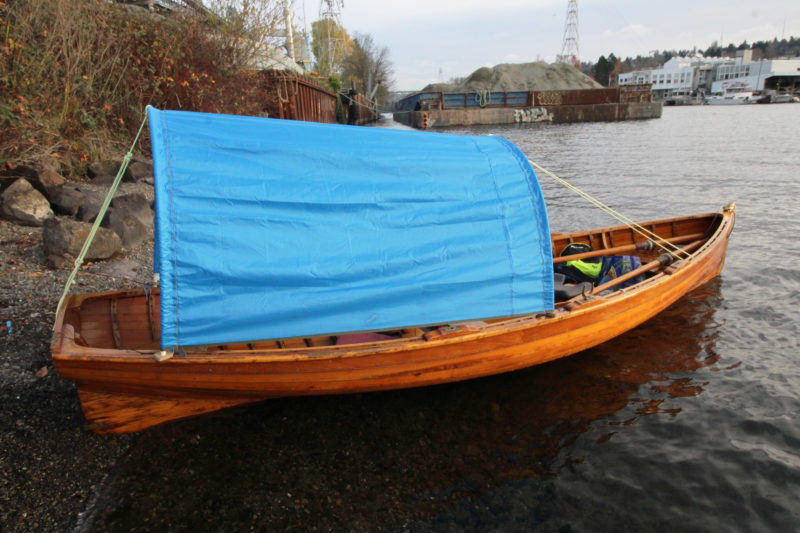
The pipes are the same length to the canopy will be taller where the span between gunwales is narrower.
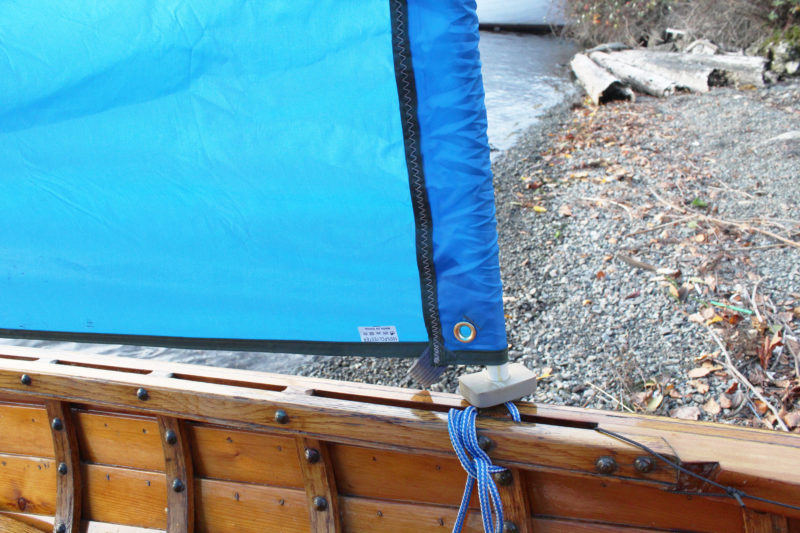
Here the 2 1/2″-wide sleeve for the pipe is evident. The tan-colored rectangle below the corner of the tarp is to hold the tarp up when visibility to the sides is required. The blue cord is threaded through the the pipe and tied around the inwale.
I made a sleeves for the pipes by folding each of the long sides back 2-1/2″ and sewed the hem. The in the middle of the sleeve’s edge I used a hot knife to cut away a semicircle of fabric. The hole is needed for the guy lines that will pull the tops of the arches to the ends of the boat. Pulling directly on the pipes instead of a grommet or webbing loop is the only way to get a smooth canopy.
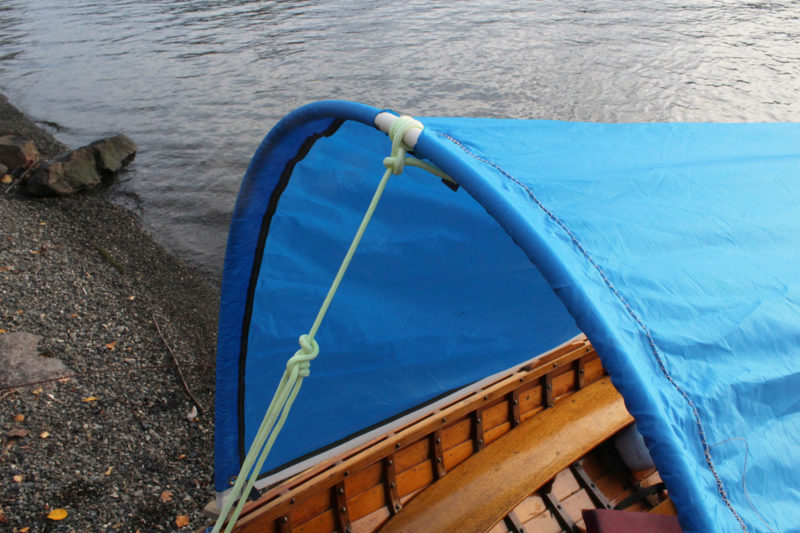
A section of the sleeve is cut away so the tensioning line can be tied around the pipe. A taut-line hitch tied close to the canopy makes it convenient to make adjustments.
To secure the pipes to the Whitehall’s open rail, I threaded a 1/4″ braided line through each pipe, cutting the lines about 6′ longer than the pipe. With the lines through the pipes and the pipes in the sleeves, I tie one end of each line around the inwale and snug the pipe up against the rail. The extra length of the line lets me thread its other end through the open rail before flexing the pipe. I can then pull the line to bring the pipe’s end to the rail. I had initially thought I’d put rods in the ends of the pipes and then set the rods in the oarlock sockets, but that limits where I can put the canopy. The cord is much more versatile and unbreakable. I tie other cords to the pipe at the top of the arch where I cut the semicircle of fabric away, taking a few wraps around the pipe for friction. I loop the other end around something in the boat and use a taut-line hitch to position the arch and tension the tarp.
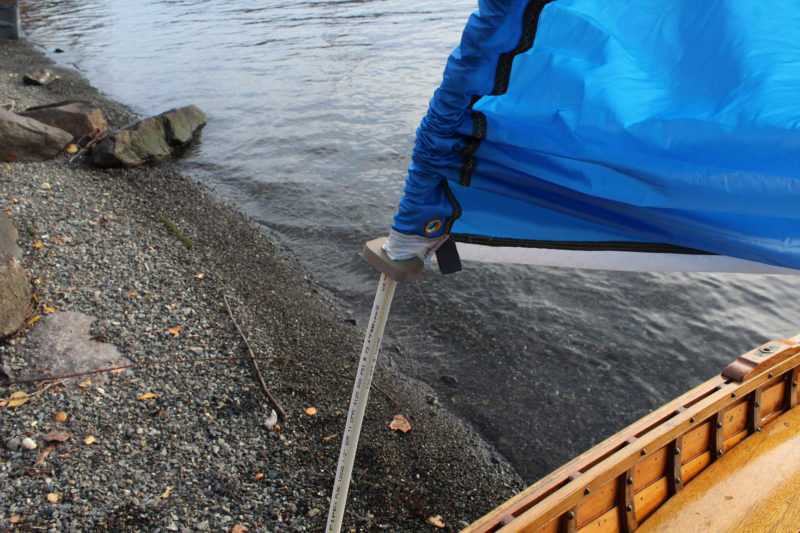
The rubber slider holds the tarp up at any height.
I had a piece of 1/2″ thick soft rubber that I cut into 1-1/2″ squares and drilled with a 5/8″ Forstner bit. Slipped over the ends of the pipes, they hold the tarp sides up when I need to see out.
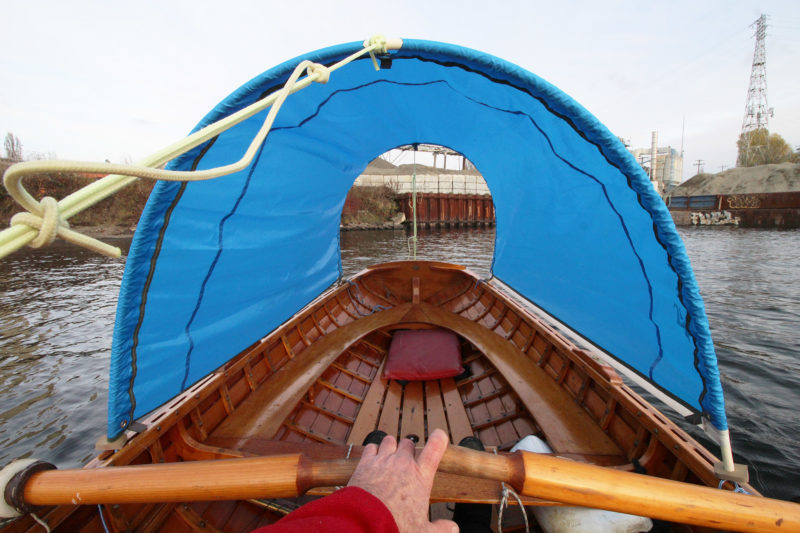
With the canopy set up in the stern, I can row from the middle or forward rowing station and carry a passenger curled up, under cover, in the stern. The line from the top of the forward arch is looped around the inwale on the starboard side, out of the way for rowing.
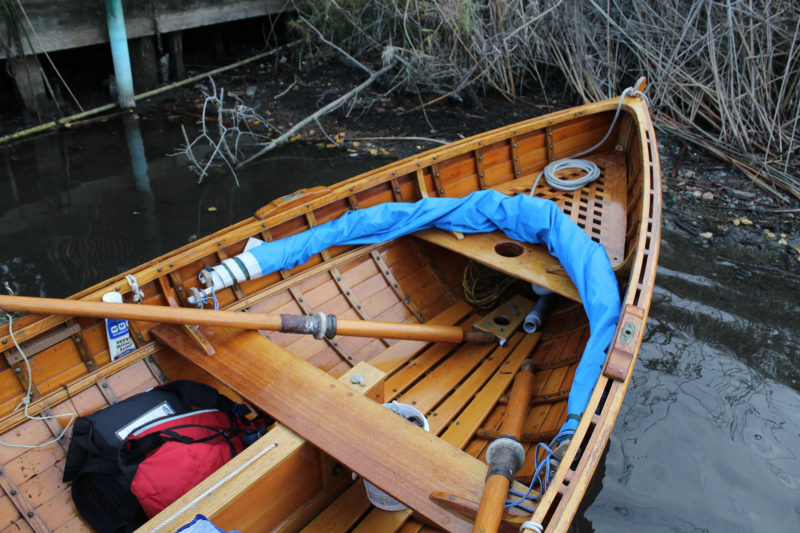
With the pipes and lines rolled up in the tarp, the bundle can be bent into place for storage rather than laid straight and flat on the floorboards where it would be underfoot.
CC

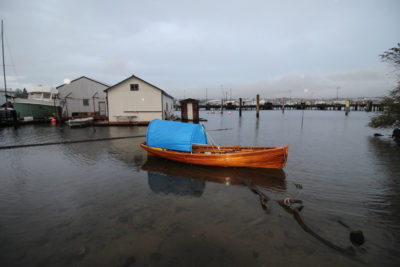
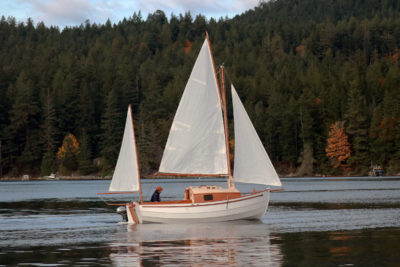
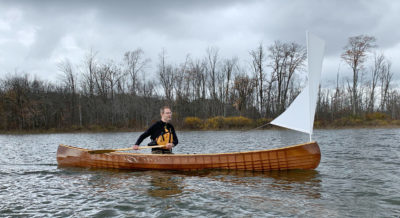
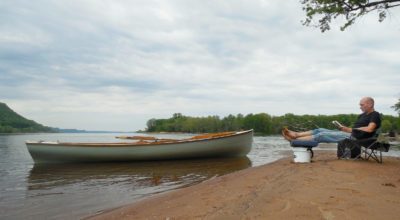
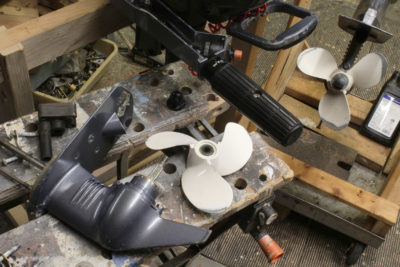

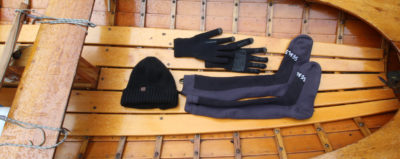
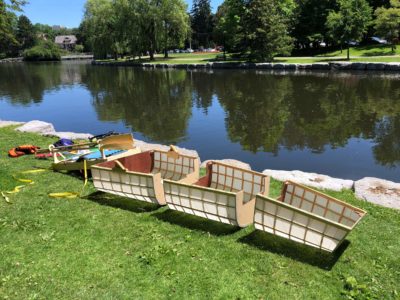
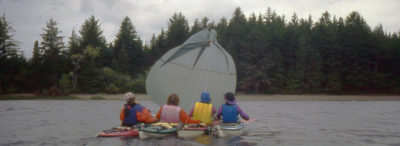
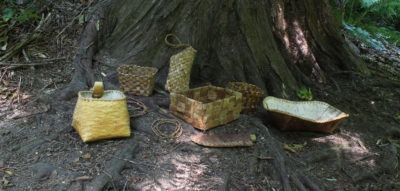
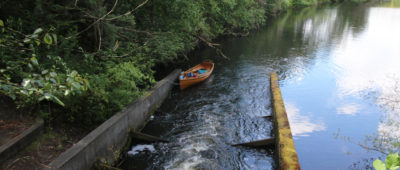
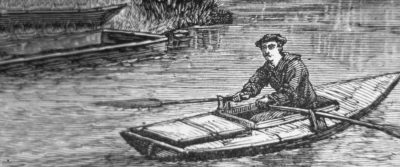
Chris,
I think your canopy is a very unique idea. Would it be possible to share your construction technique. The canopy could also be used to shade the rower or passenger on one of those scorching summer rows.
Scott,
Thanks for your interest. A fabric cover supported by hoops is an old idea. Jerome K. Jerome writes about a Thames skiff equipped with iron hoops and a canvas cover in Three Men in a Boat, published in 1889. The link will take you to the full text and you can do a search for “hoop” and the first mention will have a description and a drawing.
My system would indeed work well as a summer sunshade. I’ll add a description to the article shortly.
That’s a beautiful piece of watery meditation! Maharishi might not agree but your description sounds rather Zen-like rain-drop-mindfulness. Earth Shoes not needed here.
I have never experienced trascendental meditation, but in my very rare nights of sleeplessness, a playlist with rain sounds makes me sleep in seconds. Nothing beats that feeling.
Lovely
Chris,
Your canopy is ingenious, minimalist, functional – and you are most generous to share it. I have been riddling how to tame summer sun and rain when out in my CLC Expedition Wherry (it’s sort of a decked Whitehall) and you have solved the problem. Thank you.
David
Chris,
The article “Refuge in the Rain” brought back memories of paddling, racing, and guiding in Nebraska and Missouri. In some cases, it wasn’t only rain but also sleet and snow. Two that stand out the most:
I was guiding a group of eight fairly experienced paddlers along the Palisades on Grafton Lake north of Saint Louis. We were paddling on the south side of the river (the Missouri side). It was fall migration time and there was a flock of White Pelicans in nose to tail formation flying along the steep limestone cliff picking up thermal lifts just before a rain storm. Just guessing, I told the paddlers it was going to rain in minutes. I guided the group to beach near a picnic shelter along the shore. We needed to hurry up and wait out the rain in the dry. I nailed it—like clockwork it poured down rain with my clients and their boats undercover. We all had a nice dry snack watching the rain drops on river and the White Pelicans flying along the Palisades eventually out of sight up river.
To quote the NASCAR good old boys: Sometime the bear eats you, sometimes you eat the bear. That day the bear was extremely tasty.
It was just about time for Standing Bear Lake in Omaha to begin freezing over—mid December. We had one last paddle before the lake would eventually hard freeze and become very dangerous to kayak.
The early winter clouds were gray, fluffy, and sketchy cold. There wasn’t a lick of wind. A group of friends, all great paddlers, launched in the December day. It was dreadfully cold but all of us just had to get one last time on the water for the year. We were all properly dressed, had spray skirts, a wore either pogies or diver’s gloves. My wife, Chris, made the comment we all looked like kayaking polar bears.
We reached the middle of the lake as dark cloud drifted over us and began dumping a mixture of large white snowflakes and ice crystals. The world was shut out for about ten minutes. All we heard was the ice particles striking our decks and sizzle on the water. We all felt the snowflakes lightly touching our faces. There were no civilized noises. No sound of traffic. No visual shoreline. It was as though the lake didn’t exist. We all felt the impending winter firsthand. This was only a small taste of what was to come.
Eventually the snow cloud drifted on to the south and the sun began piercing the gray wintertime clouds. For a couple of moments, the brilliance blinded us. We drifted back into the world of traffic noise, the shoreline, and the end of our paddle until next spring when the ice and snow disappear.
I like that idea except I might try it in a “plasticpane” version on outside. It’s a see-through plastic like on marine side curtains. HH-66 glue works good instead of sewing.
Chris, “Thank You!” for the article. I am just finishing up a stem-to-stern refit of my 17′, copper-riveted lapstrake, Whitehall. I’ve been toying with various canopy ideas, but yours seems to be what I was looking for all along! Thanks again, and maybe we’ll cross wakes out there on the water someday.
Cheers!
Mark in Port Townsend
Just messing around in boats is the most joyful thing. I can’t wait to do something similar when I finish my Acorn 12′ rowboat, I will also rig it for sail. I love small boats, but I also have a Catalina 22. Spring can’t come fast enough!
Seeing your very well thought out canopy was particularly interesting as I am considering making a hard-sided version in 3mm marine plywood with top-hinged sides.
There’s something really lovely about being sheltered from rain, even whilst wearing fully waterproof gear.
Your canopy is really practical and the photograph of you happily reclined after tea and banana cake as the rain danced rhythmically on the canopy emphasised the benefit better than words ever could.
Budget Biminis — I love this. Thanks so much for posting Chris. Now I can’t wait to bliss out to the sound of the rain!